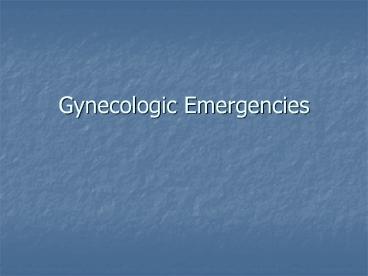Gynecologic Emergencies - PowerPoint PPT Presentation
Title:
Gynecologic Emergencies
Description:
Gynecologic Emergencies * * * * * * * * * * * * Pelvic Inflammatory Disease Breakdown of normal host barriers (cervical mucous, lysozymes, local IgA, cervix) allows ... – PowerPoint PPT presentation
Number of Views:316
Avg rating:3.0/5.0
Title: Gynecologic Emergencies
1
Gynecologic Emergencies
2
Pelvic Inflammatory Disease
- Breakdown of normal host barriers (cervical
mucous, lysozymes, local IgA, cervix) allows
ascension of pathogens. - Breakdown is most commonly secondary to
menstruation. - 80 of cases are secondary to
- N. gonorrhea and chlamydia
- Risk factors?
3
P.I.D.
- Classic picture is a sexually active woman with
bilateral abdominal pain, vaginal discharge,
fever and constitutional symptoms. - Exam reveals CMT, discharge and bilateral adnexal
tenderness.
4
What is the differential for the same
presentation with UNI-lateral adnexal tenderness?
- Ectopic
- Tubo-ovarian abscess
- Adnexal torsion
- Appendicitis
- Ovarian Cyst
5
Diagnostic Studies
- CBC
- Endocervical specimens
- B-Hcg
- Ultrasound
- Laparoscopy
6
Diagnosing PID
- Definitively diagnosed by
- confirmation of fluid filled tubes or TOA
- histopathologic confirmation of endometritis
- PID findings on laparoscopy
- Clinically diagnosed by
- a. lower abd. tenderness, CMT, adnexal tenderness
with temp, vaginal d/c, leukocytosis, GC or
chlamydia swab
7
Treatment All regimens cover GC, chlamydia,
anaerobes, G rods, strep
- Who warrants inpatient treatment?
- Outpt Ceftriaxone doxy X 14d or azithro
- Inpt Cefoxitin/Cefotetan doxy or
- Clinda gent
8
Why do we care about PID?
- It is a risk factor for future ectopic,
infertility and chronic pelvic pain - Its complications include TOA, Fitz-Hugh-Curtis
syndrome and obstetric complications
9
Cervicitis
- May be GC, Chlamydia or trich
- Clinical diagnosis (pelvic exam and wet prep)
- Think of this as on a spectrum with PID
- Tx Flagyl if trichomonads on wet prep or with
Ceftriaxone Azithro or Doxy
10
Vaginal Discharge and Vulvovaginosis
- Differentiating between trichomoniasis, bacterial
vaginosis, candidiasis and PID...
11
Trichomonas Vaginitis
- Foul smelling d/c with vaginal itching, lower
abdominal pain and dysuria - 4-28d incubation period
- Exam shows foamy, yellow-green d/c with vaginal
erythema and strawberry cervix - Wet mount shows flagellated, motile,
tear-drop-shaped protozoa with vaginal pH gt5.5 - Tx with Flagyl
- Assd with PROM, preterm delivery and postpartum
endometritis
12
Strawberry Cervix
13
Wet prep showing trichomonads
14
Vulvovaginal Candidiasis
- Overgrowth of normal vaginal flora
- Pt with vaginal itching and thin, watery to
thick, white d/c - Exam reveals thick, cottage cheese d/c,
vulvovaginal erythema, possible satellite lesions - Vaginal pH lt4.5
- tx with intravaginal azoles or po fluconazole
15
Fungus on wet prep without stain
16
Bacterial Vaginosis
- The most common cause
- Believed to be polymicrobial
- Pt. complains of itching and fishy discharge
- Dx must have ¾ homogenous d/c coating walls of
vagina (doesnt pool), whiff test, pHgt4.5, clue
cells on wet mount - Tx with metronidazole or TV clinda
- Importance increased PROM, preterm labor,
preterm birth and post-cesarean endometritis
17
Clue cell on wet prep
18
Adnexal Torsion
- An ovary twists on its vascular pedicle causing
compromised blood supply and necrosis. - Usually secondary to an enlarged or
overstimulated ovary - May occur at any age and at any point in the
menstrual cycles - Hx of sudden onset, usually unilateral adnexal
pain
19
Evaluation and Management
- CMT may be present, may be bilateral though
typically unilateral - May palpate an adnexal mass
- Afebrile or tachycardic out of proportion to
fever - Routine labs are unrevealing.
- Ultrasound
- Tx is surgical
- Consequences include shock, peritonitis, tubal
scarring
20
Abnormal Vaginal Bleeding (Non-pregnancy related)
- There are multiple etiologies
- Endocrine alterations (menopause)
- Drugs (ABX, anticonvulsants, anticoagulants)
- Infections (Vulvovaginitis, Endometritis)
- Neoplasms (Cervical, Polyps)
- Post-operative
- Trauma (Foreign bodies and straddle injuries)
- IUDs (
- Medical problems (Coagulopathies,
Thrombocytopenia) - DUB (a diagnosis of exclusion)
21
Our responsibilities are the same...
- Assuring hemodynamic stability
- Stabilizing the life-threatening bleeds
- Identifying correctable causes
22
References
- 1. Preparing for the Written Board Exam in
Emergency Medicine. 5th ed. Vol 1. Rivers,
Carol. pp 534-549 - 2. www.fertilite.org/images/ic/cervitisit_tri.gif
- 3. http//www.microbelibrary.org/microbelibrary/fi
les/ccImages/Articleimages/Buxton/0320Vaginal/Tri
chomonas20vaginalis20fig5.jpg - 4. http//www.microbelibrary.org/microbelibrary/fi
les/ccImages/Articleimages/Buxton/0320Vaginal/Can
dida20albicans20fig6.jpg - 5. http//www.fpnotebook.com/_media/GynVaginitisCl
ueCell.jpg - 6. http//download.imaging.consult.com/ic/images/S
1933033208701125/gr13a-midi.jpg































